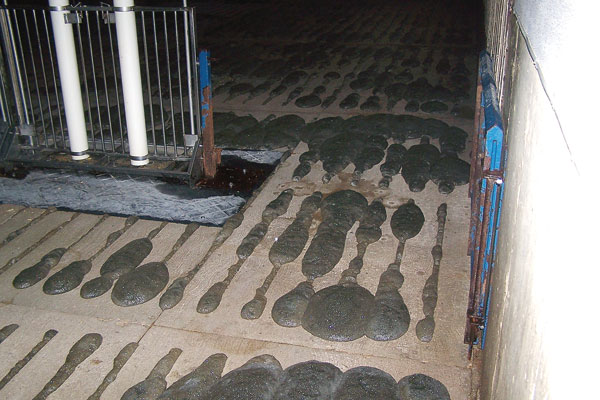Manure pit foaming research is showing some encouraging signs.
December 13, 2013

Researchers have seen some encouraging signs after the first year of a three-year collaborative research project investigating foaming manure pits under swine barns, according to an Iowa Pork Producers Association report. The research project involves nearly two dozen scientists at Iowa State University, the University of Minnesota and the University of Illinois, in addition to USDA scientists based at ISU.
Foaming problems in deep pit manure storage structures under hog buildings has been a problem in recent years. In severe cases, thick foam on the surface of manure can lead to explosions when trapped gases escape quickly.
IPPA reports that researchers have discovered some encouraging signs while wrestling with possible causes and solutions to this dangerous problem.
Like what you’re reading? Subscribe to the National Hog Farmer Weekly Wrap Up newsletter and get the latest news delivered right to your inbox every week!
Steve Hoff, ISU professor of agricultural and biosystems engineering tells IPPA, “Make no mistake, pit foaming is a complicated problem. But we’re starting to uncover promising avenues to pursue. Our goal is to find the root cause and develop ways that producers can manage pits to prevent foaming from becoming a problem.”
The researchers developed a test to help determine manure’s foaming capacity and stability. The scientists have been working to modify technology used in other industries, such as wastewater treatment and beer manufacturing, that are experienced in evaluating foam.
During the test, air is pumped through controlled volumes of manure samples at a certain rate and amount of time. The results allow evaluation of the foam level produced and the amount of time it persists. The test may help uncover whether a sample of manure is on the verge of becoming a foaming problem, or help predict the degree of severity of the foaming.
“We’re currently exchanging samples between the three universities to make sure everyone is on the same page with the test and we can achieve consistency in our measurements,” Hoff says. “But it looks like a very robust, simple, inexpensive test that scientists can use to evaluate manure under different scenarios.”
Hoff would like to see a similar test developed as a resource for producers. “A quick, simple on-farm test would help give meaningful results for producers to take action,” he says.
As part of the investigation, scientists surveyed 225 pork producers located throughout the Midwest. The survey results indicated foam was present in 24% of 1,334 pits.
“The survey asked many questions on all sorts of variables,” Hoff said. “We wanted to know about swine diets and feed additives, the kinds of detergents and cleaning agents used in barns, how many times a year manure is pumped out, what time of year did foaming become a problem how high did the foam get.”
The researchers are looking for patterns among all of the variables. However, to date, strong correlations aren’t readily apparent. “That underscores the complexity of the problem that, for some reason, involves phenomena that have coalesced over time,” Hoff says.
For pit foaming to occur, three ingredients are needed: the generation of gases; a chemical or biological surfactant that elasticizes the surface of manure; and something that lends rigidity to the foam, allowing it to gather and grow rather than dissolve or pop.
“For that third element, we’re looking at string-like bacteria and the range of sizes of particles in manure that may provide the support structure maintaining the foam,” Hoff explains. “We’re very interested in pursuing this area and what conditions may be more prevalent in barns where foaming becomes a problem vs. barns where it is not a problem.”
The scientists are working with producers located primarily in Iowa and Minnesota. “We’ve taken over a thousand samples of manure from cooperating sites where we could get really good information on management of barns, feed ingredients, biosecurity and a host of other criteria,” Hoff says.
“It was important for us to work with as many sites as we could where a set of barns were managed and treated in the same way, but where some of the pits were experiencing foaming and others were not,” he says. “That also is helping us with a grassroots view of the chemistry and biological cultures involved in foaming pits and foaming-free pits.”
The research project’s efforts also include feeding trials to look at dietary components that may have an impact on foaming; analyzing the populations of microbes from pits where foaming has been a problem to populations in non-problem barns; and evaluating the chemical and physical properties of manure, including the foaming capacity and foaming stability.
Hoff said the next two years of research may shed more light on the root cause and possibly remedies for the foaming problem. The research was launched with $1 million in support from the Iowa Pork Producers Association.
Read more about manure pit foaming:
Pit Foaming Remains Perplexing
You May Also Like



